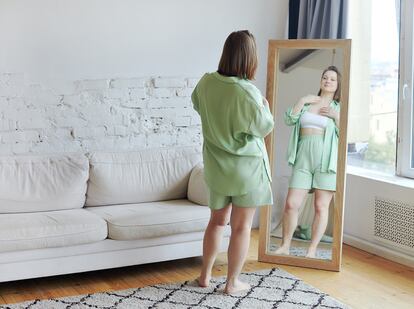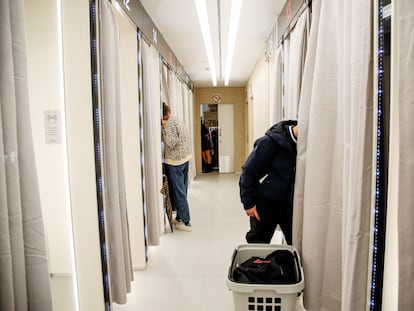The controversial Kibbe test seeks to determine which clothing works best for each person’s figure
Image consultant David Kibbe created his classification scheme in 1987, and it has recently gone viral on TikTok. But does it work, and does it include diverse body types?

The Internet is awash in all kinds of tests, from personality tests to the most bizarre quizzes that guess your age based on how you design a room. Mixing such tests with the creative and ever-changing world of fashion results in thousands of blogs and articles that claim to be able to recommend clothing styles for all body types.
Finding a personal style that looks good may seem like an easy task, but the overload of trends and the daily news of more low-cost brands makes it more complicated. Tests such as colorimetry, figures referred to as hourglass, pear, inverted triangle and now the viral Kibbe test are based on the principles of design: they use proportion, balance, color, contrast, etc., to determine what (potentially) looks best on a person.
To do this, the tests create different standardized body types, that is, labeling a body by shape or type. Marián Rubio (@anatomia), an image consultant, says it is a very useful tool in fashion; it serves as the basis of all consulting: “I always say it’s not your body, it’s the clothes you wear. Knowing what your strengths are and the clothes that can enhance them changes how you look in the mirror.”
Gloria Miguel, a psychologist at the Egoki center, comments that body typing doesn’t lead to anything good. She adds that some people—stylists or designers, for example—can use it to do their work well because clothes are made in specific ways to fit body shapes: “It’s not a matter of denying that the body has a shape, but rather a question of who defines it and to what end.”
The basis of the system
The Kibbe body type test was created in 1987 by image consultant David Kibbe, the author of the book Metamorphosis: Discover Your Image Identity and Dazzle as Only You Can. It’s almost impossible to buy a copy today; the few available ones cost €400 on Amazon or eBay. Still, through the magic of the internet, the method discussed in Kibbe’s book has reemerged and gone viral.
Kibbe created an image identity system that considers a person’s skeleton, flesh and facial features and groups them into five broad types: dramatic, classic, natural, romantic and gamine. These five are then further divided into 13 subtypes: dramatic and soft dramatic; classic, soft classic and classic dramatic; natural, soft natural and flamboyant natural; romantic and theatrical romantic; and gamine, flamboyant gamine and soft gamine.
In turn, all these types are on a spectrum that goes from yang (more masculine) to yin (more feminine). Classic types are in the middle, the dramatic and natural types with more angles are more “yang” and on the left, and the curvier romantic and gamine types are more “yin” and placed on the right.
Nekane Cuellar (@nekane_loveyourself), a plus-size model, hadn’t heard of the test but says that she was “horrified” when she read that it is divided into categories that measure the percentage of a person’s femininity and masculinity. “It seems completely absurd to me,” she says. Psychologist Gloria Miguel agrees: “I don’t understand the need to label so many body types. It resorts to connecting femininity with what it considers romantic: curves... but the reality is that being and feeling like a woman goes beyond how curvy one is or is not.”
A test for everyone?
The test’s growing popularity has both delighted and worried its creator. Kibbe, 66, sees that hundreds of people on social media now believe that they are experts on the subject. In his most recent interview with The New York Times, he observed that many of the principles on which his arguments are based have been taken out of context. Furthermore, he emphasizes that “you need to have experience (in image consulting) to do this for someone else.”
Mr. Kibbe does not deny the importance of an online presence. He himself participates in the Strictly Kibbe Facebook group, which, even today, is the only creator-approved forum/website. The group is made up entirely of women, with the exception of Kibbe, although he participates using his wife’s profile.
Kibbe provides examples of each body type. In his book, the author shares a list of celebrities who fit into each category, primarily actresses from the golden age of Hollywood and celebrities from decades ago: Sophia Loren, Ingrid Bergman, Joan Crawford, Grace Kelly, Liza Minelli, Jackie O... Although the women are different, they are all beautiful and slim, as defined by the industry’s beauty standards at the time. Nowadays, virality on social media has made celebrities more inclusive and diverse.
The Kibbe test has given rise to a variety of opinions. On the one hand, content creator and writer Adriana Boho (@adrianaboho), believes that while it is difficult for a single test to categorize all body types, it can be a good starting point. Vai Sawaneh, better known as @betweenmyclothes, agrees that it can offer helpful guidance and adds that the test is intended for those people who are interested in taking it.
On the other hand, image consultant Marián Rubio says that it is very difficult to see yourself reflected in these images. She points out that it leaves out many body types. Aitziber Badiola (@aitziber_personalstylist), a personal stylist, adds that a person’s body type and style should not be tied to metrics. Cuellar agrees: “I don’t think any body type is meant to be pigeonholed in a test; everyone should be free to dress as they please.”
Gloria Miguel believes that we must be careful with this type of test: “It can create significant pathologies in people who have difficulty accepting their bodies, because they see that they do not fit the standard.” She stresses that bodies should not become trendy, and that beauty standards, which tests like Kibbe’s promote, are highly subjective and extremely confusing for people who are discovering their identities.
The experts all agree that fashion is a mode of free expression that does not need to be subjected to imposed rules. They emphasize that only people in good mental health should take the Kibbe test, because it thoroughly analyzes all parts of the body. Only stylists Marián and Aitziber have taken the test; both say that they did not completely agree with the test’s results and note that the quiz is overly complex. “It seems to me that you are a prisoner of the test. The only way to get it right is for David himself to do it for you; if you do it without him, you get the sense that [your] answers are not correct,” Marián points out. She adds that the initial purpose of Kibbe’s body types has been lost amid its current popularity: the system was originally designed to be Kibbe’s business.
Sign up for our weekly newsletter to get more English-language news coverage from EL PAÍS USA Edition
Tu suscripción se está usando en otro dispositivo
¿Quieres añadir otro usuario a tu suscripción?
Si continúas leyendo en este dispositivo, no se podrá leer en el otro.
FlechaTu suscripción se está usando en otro dispositivo y solo puedes acceder a EL PAÍS desde un dispositivo a la vez.
Si quieres compartir tu cuenta, cambia tu suscripción a la modalidad Premium, así podrás añadir otro usuario. Cada uno accederá con su propia cuenta de email, lo que os permitirá personalizar vuestra experiencia en EL PAÍS.
¿Tienes una suscripción de empresa? Accede aquí para contratar más cuentas.
En el caso de no saber quién está usando tu cuenta, te recomendamos cambiar tu contraseña aquí.
Si decides continuar compartiendo tu cuenta, este mensaje se mostrará en tu dispositivo y en el de la otra persona que está usando tu cuenta de forma indefinida, afectando a tu experiencia de lectura. Puedes consultar aquí los términos y condiciones de la suscripción digital.
More information
Archived In
Últimas noticias
Most viewed
- Reinhard Genzel, Nobel laureate in physics: ‘One-minute videos will never give you the truth’
- Oona Chaplin: ‘I told James Cameron that I was living in a treehouse and starting a permaculture project with a friend’
- Pablo Escobar’s hippos: A serious environmental problem, 40 years on
- Why we lost the habit of sleeping in two segments and how that changed our sense of time
- Chevy Chase, the beloved comedian who was a monster off camera: ‘Not everyone hated him, just the people who’ve worked with him’










































